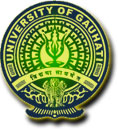/topics/governance
Governance
Gauhati University invites applications for Assistant Professor, Guwahati Apply by May 26, 2012
Posted on 16 May, 2012 12:24 PM
India Water Portal invites applications for interns for the Data Project
Posted on 10 May, 2012 11:12 AM
How soil and water conservation transformed the lives of people in a remote village - The case of Gulliyada village in Talavadi block of Erode district, Tamil Nadu
Posted on 09 May, 2012 04:12 PMAuthor: Seetha Gopalakrishnan
MYRADA and the Krishi Vigyan Kendra in Erode district, Tamil Nadu
Privatisation of urban water supply in Khandwa, Madhya Pradesh - An update from Manthan Adyayan Kendra
Posted on 09 May, 2012 09:53 AMStartling conditionalities
Water science in India - Hydrological obscurantism - A paper in Economic and Political Weekly
Posted on 07 May, 2012 12:15 PMThis article by Jayanta Bandyopadhyay in the Economic and Political Weekly deals with the Government of India’s proposal for addressing the twin problems of floods and water scarcity by interlinking rivers.
Teesta, Tipaimukh and riverlinking: Danger to Bangladesh-India relations – A paper in Economic and Political Weekly
Posted on 06 May, 2012 11:25 AMBangladesh shares 54 rivers with India. Any unilateral action by India on any of its international rivers will degrade its relations with its neighbours while also adversely affecting its ecology, economy and society. Bangladesh being a riverine and a lower riparian country remains sensitive to matters of water, whether inland or maritime.
NABARD invites applications for "Award for Rural Innovations", Mumbai, Apply by May 15, 2012
Posted on 04 May, 2012 12:01 PM
NABARD is set up as an apex Development Bank with a mandate for facilitating credit flow for promotion and development of agriculture, small-scale industries, cottage and village industries, handicrafts and other rural crafts.
Fluorosis mitigation in Dhar, Madhya Pradesh: Experiences of monitoring fluoride levels in drinking water and human urine, and implementing mitigation measures
Posted on 04 May, 2012 08:48 AMBackground:
62 million people in India, including 6 million children suffer from fluorosis. The root cause of this is excessive fluoride (>1.5mg/l) in groundwater, as is found in 20 states across India.
Objectives:
The Supreme Court and its directions on Interlinking of Rivers (ILR): India and her people will be greatly benefited by its implementation
Posted on 03 May, 2012 07:03 PMAuthor : J. Prabudoss
Viability of Clean Development Mechanism (CDM) projects in India: Study of Chanju CDM project in Chamba district,Himachal Pradesh
Posted on 03 May, 2012 06:30 PMThe present paper is an attempt of the researcher to make a comparative analysis between the expected benefits received by the executing agency under CDM and the actual benefits people are expected to receive from Chanju-I Hydro Electric Project.






